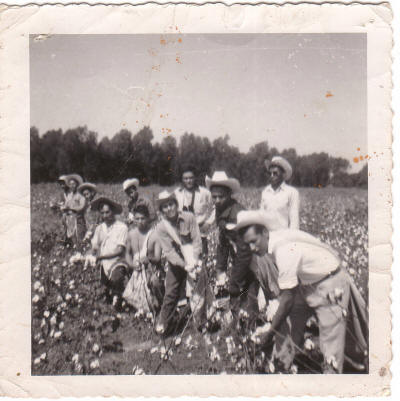University
Communications
Office
Arkansas State University
Jonesboro,
Arkansas
Staff
Markham Howe
Sara McNeil
Gina Bowman
(870) 972-3056
fax (870) 972-3069
More information:
NewsPage
Links to News Releases
& Announcements
Campus Calendar
Public activities at ASU
Campus News
Faculty and Staff
achievements
About
ASU
Overview, history
and more |
ASU partners with Smithsonian,
Bracero History Archive, in oral history project
Aug. 28, 2008 --
Arkansas State University will partner with the Smithsonian
National Museum of American History and its partner, the University of
Texas-El Paso, to host a series of collection days throughout Arkansas
to record oral histories as part of the Bracero History Project, a
consortium of museums, universities and cultural institutions, including the National Museum of American History, the
Institute of Oral History at the University of Texas at El Paso, the
Center for History and New Media at George Mason University, Brown
University, and ASU.
institutions, including the National Museum of American History, the
Institute of Oral History at the University of Texas at El Paso, the
Center for History and New Media at George Mason University, Brown
University, and ASU.
ASU’s participation in this project is due to its position as the major
university in the Arkansas Delta, its Ph.D. program in Heritage Studies,
with its focus on the region, and its rich archives. The Archives and
Special Collections at ASU’s Dean B. Ellis Library includes the papers
of Congressman E.C. “Took” Gathings, who served in the U. S. Congress
during the bracero program and was involved in legislative and practical
matters concerning the program. ASU’s oral history project, “The
Arkansas Delta in Transition,” has already collected several oral
history interviews related to the bracero program.
Dr. Brady Banta, associate director of ASU’s Heritage Studies Ph.D.
program and archivist of ASU’s Dean B. Ellis Library, says, “These
interviews sparked our interest in documenting the agricultural labor
arrangements employed during the transition from sharecropping and
tenant farming to the development of the mechanized and scientific
agriculture that we see around us today.
“This was a time
of significant economic and social transformation in Eastern Arkansas.
Documenting the Bracero Program provides an opportunity to explore these
changes at a personal level by recording the memories of a unique and
short-lived set of circumstances.”
The Bracero History Project seeks to preserve and collect the history of
the guest worker program, the bracero program, that resulted from an
agreement between the United States and Mexico from 1942-1964. In
Spanish, “bracero” means worker or laborer, and has its roots in the
Spanish word for arm, “brazo.” The bracero program literally brought in
extra pairs of arms to perform manual labor. The oral histories and some
of the relevant objects collected by ASU will be added to the Bracero
History Archive (BHA), an archive of sound files, transcripts of
interviews, photographs, documents, and other items of interest.
In 1942, the U.S. and Mexico entered into a series of agreements to
organize a program of mutual benefit. The U.S. was experiencing a labor
shortage due to World War II, and the bracero program allowed Mexican
citizens to work in the U.S. legally as temporary contracted labor,
largely in the field of agriculture. More than four million Mexican men
entered the U.S. to work, initially in California and Texas, but
spilling into the Arkansas Delta by 1948. At one point during the
program’s lifespan, some 25 per cent of cotton labor in the Arkansas
Delta was Mexican. The addition of bracero labor had a significant
impact upon the region’s black and white tenant farmers and day
laborers—the bracero labor force had an influence upon Arkansas’
agricultural economy, its industrial technology, and its culture. The
Mexican government established a consulate in Memphis to monitor the
conditions of braceros on farms, and constant conflict ensued between
the consulate and the farmers who recruited, worked, and housed braceros.
In the early 1960s, mechanical cotton pickers became more common, and
the number of braceros, as well as other field laborers, declined.
The main week of interviewing will take place in various locales in
Arkansas during the week of Sept. 22-26. The project seeks to collect at
least 25 oral history interviews, collect relevant objects for the
Bracero History Archives, and educate local communities about the
history of the bracero program in Arkansas. Since few, if any, former braceros remain in the region, the project will focus on farmers,
African American tenant farmers who hired braceros, white and African
American laborers who worked alongside braceros, and/or were affected by
the bracero presence. In addition, the project will also focus on
merchants, store clerks, other business people, such as insurance agents
and bankers, and professionals like doctors and dentists in towns
frequented by braceros.
Relevant objects sought include period hand tools, clothing,
photographs, and documents including contracts, identification cards,
and letters.
For more information about the Bracero History Project, visit
www.braceroarchive.org. To
schedule an interview, call Dr. Brady Banta at (870) 972-2612, or e-mail
him at bbanta@astate.edu.
Photo above:
Braceros pick cotton in Arkansas.
Photo courtesy of
the University of Texas El Paso, Institute of Oral History.
###
|
